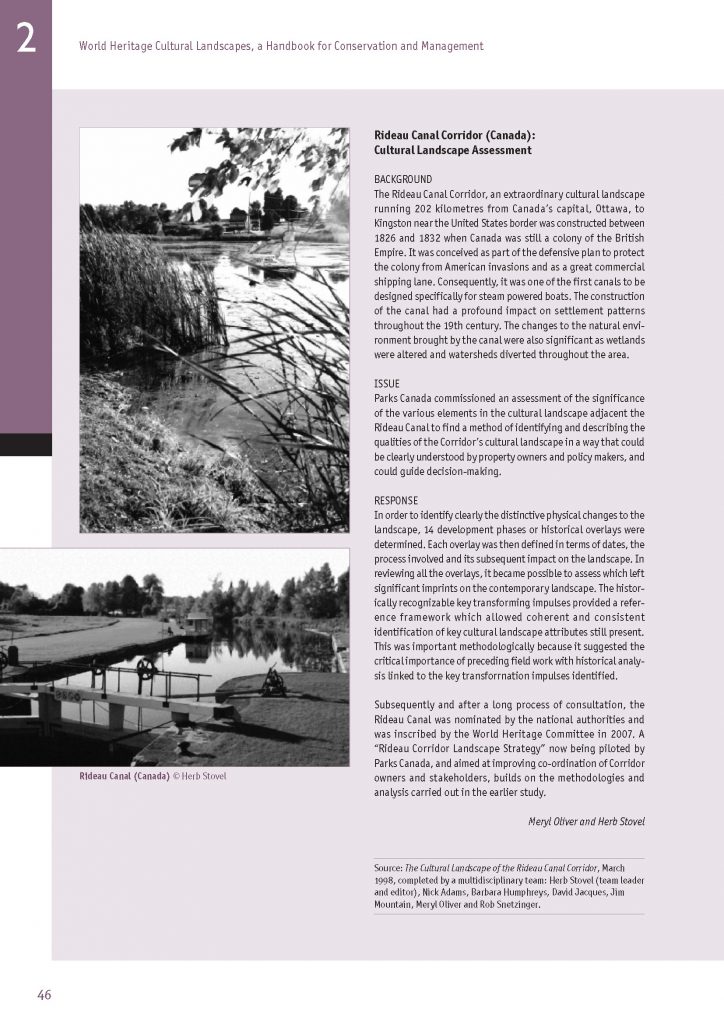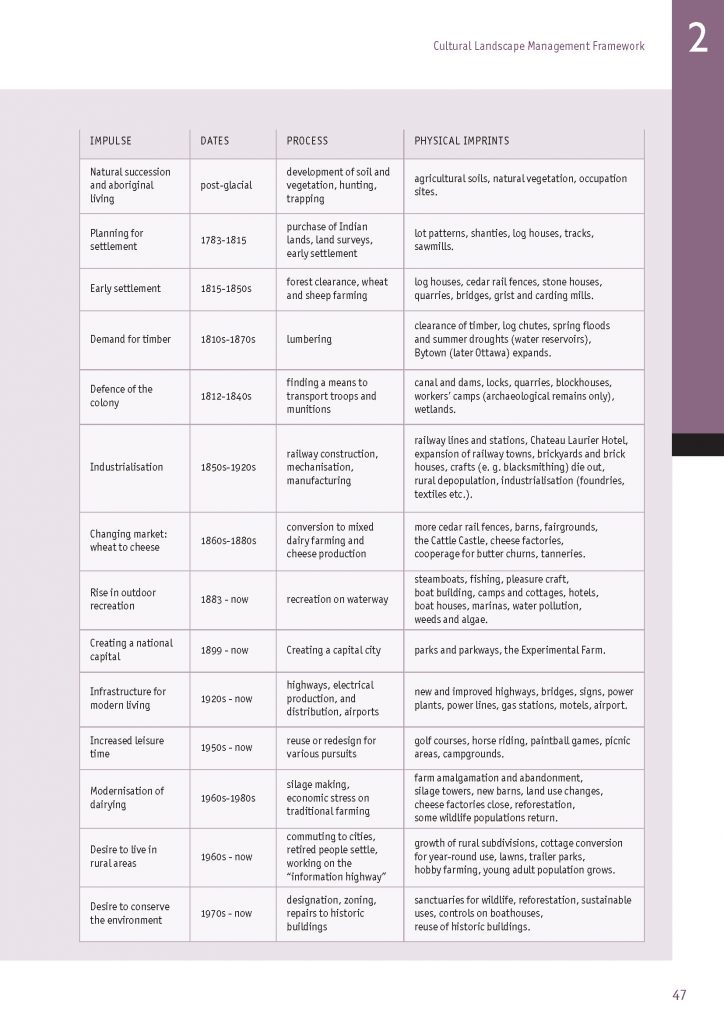Sustainability challenges in Canada’s World Heritage Site Rideau Canal
Case Study prepared by Kamal Raftani, Graduate Diploma in Architectural Conservation Student, Carleton University
Keywords: World Heritage, Sustainability, Heritage, Landscape, Canal, Rideau Corridor, Waterway

LESSONS LEARNED
The Rideau Canal waterway cannot be seen in isolation from the rich cultural landscape corridor, urban, suburban and rural, that it is part of from Ottawa to Kingston. In the Ottawa section, the Rideau Canal waterway and the surrounding urban areas form a harmonious setting that contributes significantly to the unique character of the historic urban landscape. However, recent development projects such as the Ottawa Convention Centre and the proposed addition to the Chateau Laurier showed that it is this proximity to the urban core area of the city that represents the primary risk of negatively impacting the integrity and visual character of the heritage resource.
Within Ottawa, the Rideau Canal is used as a transportation corridor to move in and out of the urban centre through a network of motor vehicles, cyclists, and pedestrians’ infrastructure. On the other hand, in several locations along its pathway, the Canal constitutes a barrier between neighbourhoods, limiting the movement of pedestrians and cyclists. This is despite the Rideau Canal’s potential to enhance connectivity along and across the Canal by balancing all modes of transportation, especially to respond to increasing plans for walkability.
At the same time, recent development pressures related to the construction of two pedestrian bridges over Rideau Canal (Corktown and Flora Footbridges) brought out many community stakeholders. This shows how important it is to strengthen and sustain the commitment of both local communities and communities of interest throughout the various phases of such projects.
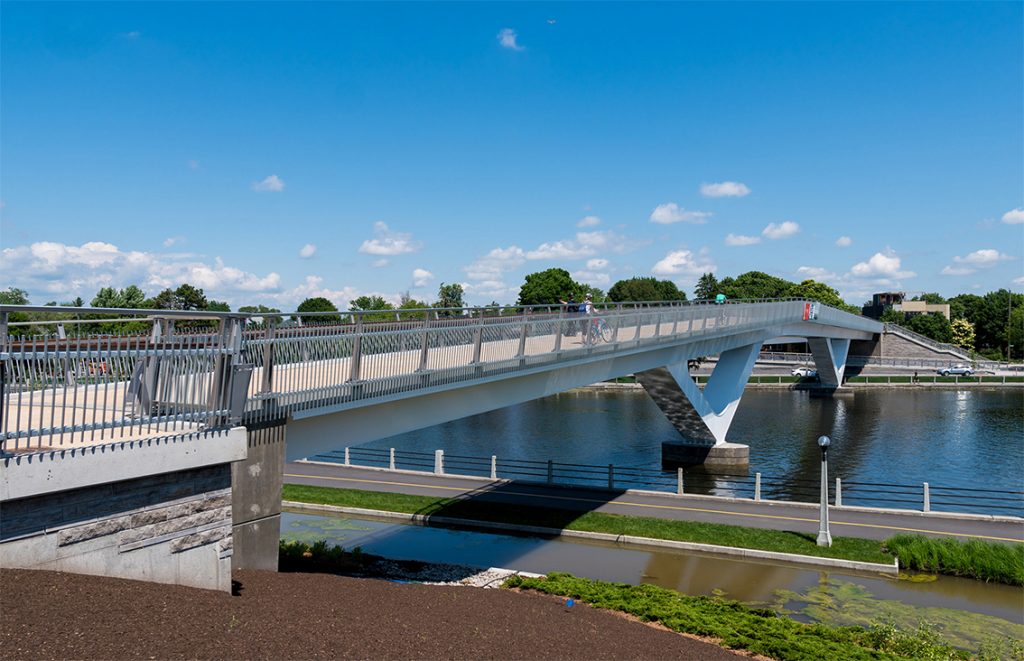
The Rideau Canal provides a positive year-round asset for the City. In winter, the Rideau Canal Skateway is a popular recreation site that brings vibrant recreational activities to the Canal. In the summer, the waterway provides a scenic navigable channel for a variety of vessels. However, the image of the Canal remains tied closely to the operation of the locks for boats in the summer and to skating during the winter (Holthof, B., et al., 2013). This shows the need for a long term tourist strategy for the Canal that will provide recreational opportunities for both local residents and tourists throughout the year.
“The Rideau Canal Corridor is a complex multi-jurisdictional landscape, with federal, provincial, and municipal levels of government, as well as Algonquin Traditional Territory in the Ottawa River Watershed” (Parks Canada, 2012).
These various layers of conservation and management policy from different jurisdictions and agencies induce a broad range of interests that does not always align. A successful management of the resource requires a comprehensive approach, in which all stakeholders recognize each other’s strengths and work together with the spirit of collaboration. The Rideau Corridor Landscape Strategy, developed since the designation of the Canal as a World Heritage Site, helps facilitate such an approach.

PRESENTATION
This presentation took place on Nov. 28, 2019. It briefly outlines the key points of this case study.
DESCRIPTION
“The Rideau Canal is a 202-km slackwater canal, consisting of navigable lakes and rivers and excavated channels, connecting Ottawa, the nation’s capital on the Ottawa River, and Kingston on Lake Ontario. The canal includes fifty locks at twenty-four lockstations, seventy-three dams, and 19 km of excavated channels.” (Parks Canada, 2005).The Rideau Canal played a key role in shaping the City of Ottawa since its construction in the early nineteenth century. “The City exists because of the Rideau Canal and owes much of its early development and eventual political prominence to the canal’s construction” (Parks Canada, 2012).
The Canal was constructed as a transportation route to carry people and supplies to Upper Canada without using the St. Lawrence River, which would have been threatened by American forces in the event of conflict (Bytown Museum, 2013). When the railway came to Bytown in 1854, the Canal’s edges became an important area for industrial development with the establishment of rail infrastructure, coal sheds, lumberyards, and other industrial sites along the Canal (Parks Canada, 2012). In 1856, the Rideau Canal was transferred from British military control to the government of the Province of Upper Canada (Watson, 2012).
By the end of the 19th century, Ottawa had changed from a lumber town to manufacturing city to a National Capital. In 1899, the Ottawa Improvement Commission (OIC) was established to improve the city. One important task was to beautify the banks of the Rideau Canal (National Capital Commission, 2013). With the Gréber Plan of 1950, the industry around the Canal was moved to external sites around the city to free up land for other purposes (Gréber, 1950) and the rail lines along the Canal were replaced by Colonel By Drive in the mid-1960s.
The 20th century saw an increasing recognition of the cultural, natural and recreational values of the Rideau Canal. In 1925, the Canal was designated a National Historic Site. The Ministry of Transportation transferred authority over the Rideau Canal to Parks Canada in 1972. Then, in February 2000, the Rideau Waterway was designated as a Canadian Heritage River for its outstanding human heritage and recreational values. These include the Canal system, its historical setting, the wide range of water based recreational activities, and water quality suitable for recreation (Parks Canada, 2005).
In 2005, Parks Canada prepared the Rideau Canal National Historic Site Management Plan which establishes the long-term strategic direction for the management of the Rideau Canal National Historic Site. This plan seeks to ensure the commemorative integrity of the NHSC; guides appropriate public use; ensures the application of cultural resource management principles and practices in the decision-making process; and, conserves the natural values of the Rideau Canal.
In 2007, the Rideau Canal was designated a UNESCO World Heritage Site for its Outstanding Universal Values. In anticipation, Parks Canada prepared the Rideau Canal World Heritage Site Management Plan in 2005 to specify how the values of the site will be protected for present and future generations. The Rideau WHS Plan identifies the values that will be protected; the legislative and policy framework for the management of the property; the elements of the management system in place to protect the property; and, the mechanisms for monitoring and periodic reporting (Golder Associates Ltd., 2017).
“When the Rideau Canal was inscribed on the UNESCO World Heritage List in 2007, it was noted that appreciation of the canal’s scale and its impact on its surroundings have a visual dimension and recommended that consideration be given strengthening its visual protection outside 30m buffer zone, which corresponds with the 30m minimum setback for waterfront development. This recommendation further reinforces the significance of the waterway, and was the impetus behind the development of the Rideau Corridor Landscape Strategy.” (Report to the Planning Advisory Committee, 2019)
Recent development projects such as the Ottawa Convention Centre and the Chateau Laurier proposed addition showed that threats on the visual setting and the character of the cultural landscape continue to be a matter of concern.
Significant environmental challenges facing the Rideau Canal include close proximity of development to the shorelines. In the City of Ottawa, where the linear corridor sits adjacent to several neighbourhoods, it is worth remembering that the way “how land is used and how development is managed and serviced in urban areas are of huge significance in the pursuit of environmental sustainability.” (Ottawa Insights (2019) Land Use and Ecology. Retrieved from: https://www.ottawainsights.ca/themes/environment-and-sustainability/land-use-ecology/).
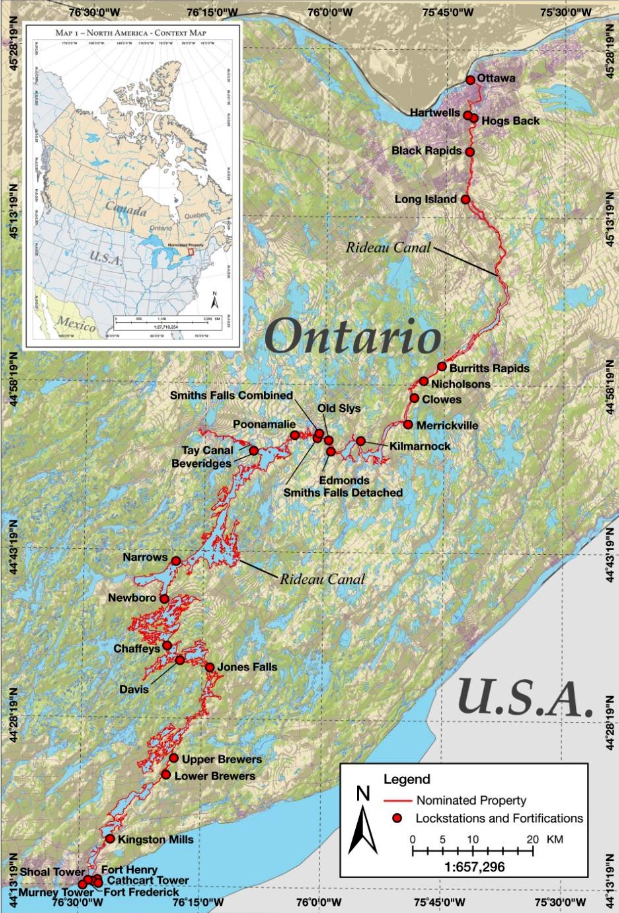
TIMELINE
| Early 1600’s | At the time of European contact, the Ottawa River watershed was inhabited by Algonquin peoples. Despite being largely dispossessed by other groups in later years, they have never surrendered their claim to the land (Roche-NCE Inc, 2009, p. 2). | |
| Until the late 1800’s | The Rideau route saw continual use as an Indigenous travel way between Lake Ontario and the Ottawa River (Roche-NCE Inc, 2009, p. 2). | |
| 1826 – 1832 | Construction of Rideau Canal for military reasons under supervision of Lieutenant Colonel John By of the Royal Engineers | |
| 1854 | Establishment of rail infrastructure and the Rideau Canal’s edges became an important area for industrial development | |
| 1856 | Transfer of Rideau Canal from British military control to the government of the Province of Upper Canada | |
| 1899 | Establishment of the Ottawa Improvement Commission (OIC) to improve the city | |
| 1925 | The Canal was designated a National Historic Site of Canada | |
| 1950 | Industry around the Canal was moved to external sites around the city | |
| Mid-1960s | Rail lines along the Canal were replaced by Colonel By Drive | |
| Winter of 1970-71 | Beginning of the Rideau Canal Skateway | |
| 1972 | Transfer of the Canal from the Department of Transport to Parks Canada | |
| 2000 | Rideau Canal designated a Canadian Heritage River | |
| 2007 | Rideau Canal designated World Heritage Site | |
| 2007-2008 | Launch of the Rideau Corridor Landscape Strategy’s process | |
| 2008 | National Geographic Society distinction | |
| 2012 | Release of the Rideau Corridor Landscape Character Assessment and Planning and Management Recommendations Report |

STAKEHOLDERS
- UNESCO (World Heritage Committee, and advisory bodies)
- 3 Federal agencies (Parks Canada, National Capital Commission, Department of National Defence)
- Province of Ontario (8 Provincial ministries and 2 conservation authorities)
- City of Ottawa + 12 other municipalities
- Not for profit organizations (e.g. The Rideau Heritage Route Tourism Association, Friends of the Rideau)
- Local residents and citizens groups
- First Nations communities
- Private property owners and businesses
CULTURAL AND NATURAL HERITAGE
Rideau Canal World Heritage Site: In 2007, the Rideau Canal was designated a UNESCO World Heritage Site for its Outstanding Universal Values recognized in the following statement:
“The Rideau Canal is a large strategic canal constructed for military purposes which played a crucial contributory role in allowing British forces to defend the colony of Canada against the United States of America, leading to the development of two distinct political and cultural entities in the north of the American continent, which can be seen as a significant stage in human history.
- Criterion (i): The Rideau Canal remains the best preserved example of a slackwater canal in North America demonstrating the use of European slackwater technology in North America on a large scale. It is the only canal dating from the great North American canal-building era of the early 19th century that remains operational along its original line with most of its original structures intact.
- Criterion (iv): The Rideau Canal is an extensive, well preserved and significant example of a canal which was used for a military purpose linked to a significant stage in human history – that of the fight to control the north of the American continent.
The nominated property includes all the main elements of the original canal together with relevant later changes in the shape of watercourses, dams, bridges, fortifications, lock stations and related archaeological resources. The original plan of the canal, as well as the form of the channels, has remained intact. The Rideau Canal has fulfilled its original dynamic function as an operating waterway without interruption since its construction. Most of its lock gates and sluice valves are still operated by hand-powered winches.
All the elements of the nominated area (canal, associated buildings and forts) are protected as national historic sites under the Historic Sites and Monuments Act 1952-3. A buffer zone has been established. Repairs and conservation of the locks, dams, canal walls and banks are carried out directly under the control of Parks Canada. Each year one third of the canal’s assets are thoroughly inspected by engineers. A complete inventory thus exists of the state of conservation of all parts of the property. A Management Plan exists for the canal (completed in 1996 and updated in 2005), and plans are nearing completion for Fort Henry and the Kingston fortifications. The Canal Plan is underpinned by the Historic Canals Regulations which provide an enforcement mechanism for any activities that might impact on the cultural values of the monument.”
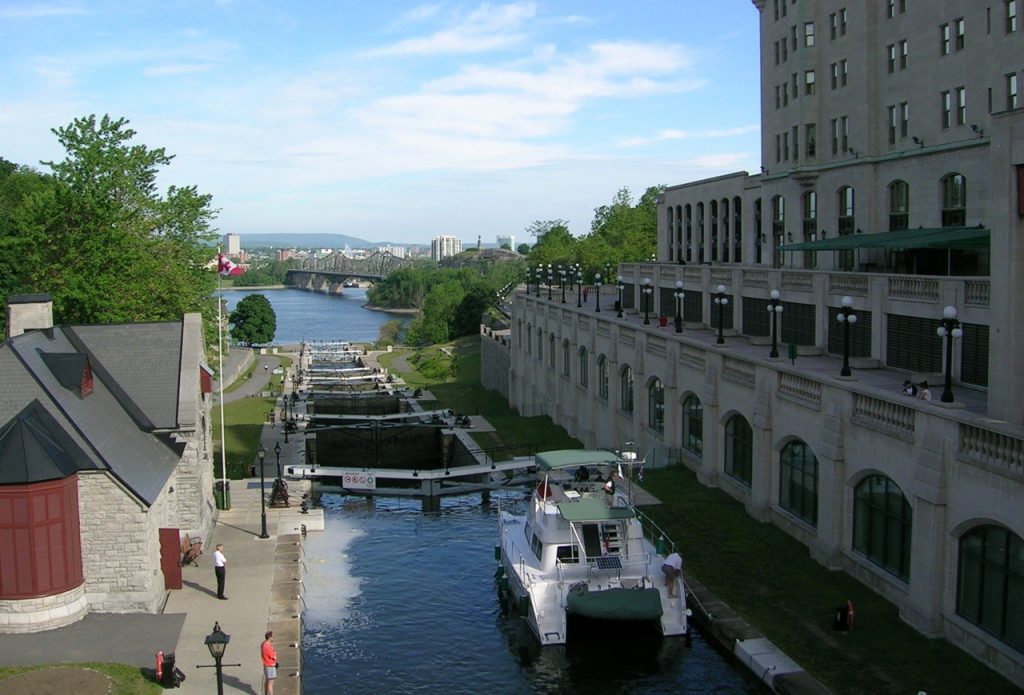
Rideau Canal National Historic Site of Canada: Rideau Canal is also recognized as a National Historic Site of Canada (NHSC). The Canal was designated NHSC because:
- built between 1826 and 1832, it is the best preserved canal from the great canal-building era in North America that is still fully operational: its historic structures and environment speak to its ingenious design, construction, and military purpose, as well as to its social and economic functions;
- it exemplifies cutting edge canal design due to Lieutenant-Colonel John By’s innovative “slackwater” approach, which created a navigable route from natural waterways and lakes on a scale previously unseen in North America, and because it was one of the first canals in the world engineered specifically for steam-powered vessels;
- its construction through more than 200 kilometers of bush, swamps, and lakes was a monumental feat. Each year, as many as 5,000-6,000 workmen assembled at over two-dozen worksites. The great majority of the labourers were Irish and French Canadian toiling under the supervision of contractors and the Royal Engineers. Working primarily with hand tools and in extremely difficult and dangerous conditions, these labourers and skilled craftsmen, such as Scottish stonemasons, endured disease and injury, with large numbers dying during the canal’s construction;
- in the aftermath of the War of 1812, when relations with the United States were tense, it was built to serve as a military canal and represented a fundamental component of Britain’s defences in the interior of North America, safeguarding the supply lines between Montréal and Lake Ontario by providing an alternative and more defensible route to that along the St. Lawrence River;
- it contributed significantly to the social and economic development of Upper Canada / Ontario prior to 1850, when it was a key artery for the movement of goods and people in and out of the colony. After that time, it continued to be of local commercial importance until the 1930s; since then it has served as a popular recreational route.
The heritage value of the Rideau Canal lies in the health and wholeness of its cultural landscape, as a witness of the early 19th-century forms, materials and technologies of the waterway, and as a dynamic reflection of the longstanding human and ecological inter-relationships between the canal and its corridor. The Rideau Canal was built for the British government by Lieutenant-Colonel John By as a defensive work in 1826-1837. Canada assumed responsibility for its management in 1855, and the waterway served as a commercial transportation route through most of the 19th and 20th centuries. Parks Canada acquired the canal to sustain its recreational operation in 1972. (Parks Canada (2019) Rideau Canal National Historic Site. Retrieved from: https://www.pc.gc.ca/apps/dfhd/page_nhs_eng.aspx?id=503)

Rideau Waterway Canadian Heritage River: In February 2000, the Rideau Waterway was designated as a Canadian Heritage River in for its outstanding human heritage and recreational values:
Cultural Heritage: The Rideau canal system, the oldest continually functioning in North America, is a testament to the ingenuity and perseverance of Lieutenant-Colonel John By and others involved in its construction. Built between 1827 to 1832 to provide a safe bypass from Montreal to the south in case of war with America, this trade and commerce route never fell under attack. The 47 locks and many of the original buildings survive to this day. A national historic site and UNESCO World Heritage Site, the cultural heritage of this waterway can be explored through the numerous museums located in communities along its shores.
Recreational Heritage: The Rideau is a top destination in North America for pleasure boating. To this day, the locks are opened and closed using the original “crab” winches. Boaters must pay fees to pass through the locks and require a mooring permit if they wish to tie up overnight. Camping and toilet facilities can be found at most lockstations. There are also private campgrounds and provincial parks along the route; plenty of hotels and bed-and-breakfasts are also available for canal travellers.
Every winter, a 7.8 km section of the Rideau Canal is transformed into the world’s largest skating rink. Running from Dows Lake to downtown Ottawa, steps away from the Parliament Buildings, the skateway is a must-see tourist destination for the national capital in the winter months.
Nota Bene: The following sections of the case study focus on the area of the Canal located within the City of Ottawa, which extends more than eight kilometres from Hog’s Back to the Ottawa River.

SUSTAINABILITY
Environmental sustainability: The Rideau Canal, including its tributary lakes and rivers, is an important environmental resource that supports a tremendous variety of species of animals such as fish (ie. bass and pike), birds (i.e. loons, herons, blackbirds, ducks, marsh wrens, least bitterns), frogs, turtles and muskrats. Some of these are “species at risk” (i.e. least bitterns and stink pot turtles). (Parks Canada, (2019) Rideau Canal National Historic Site. Retrieved from: https://www.pc.gc.ca/en/lhn-nhs/on/rideau/info/vegetation)
A Landscape Character Assessment and Planning and Management Recommendations Report commissioned by Parks Canada in 2012, as part of the Rideau Corridor Landscape Strategy, proposed ten principles that provide guidance on how waterfront and shoreline development and redevelopment can respect, protect and enhance the Rideau Canal values, through property owner’s actions and municipal decision making:
- “Understand and respect the local landscape character
- Conserve historic buildings and cultural heritage features
- Conserve, protect and enhance wetlands
- Maintain and retain natural shoreline
- Locate development back from the shoreline
- Work with the landscape, not against it
- Design buildings to complement the site
- Design residential docks and boathouses for low impact
- Protect water quality
- Prevent hazards and property damage”
Specific Approaches for the Ecological Landscape have been developed as part of the Rideau Corridor Landscape Strategy. The ecosystem of the Corridor’s landscape plays a fundamental role in defining its character. Maintaining the health of the natural heritage system is vital to maintaining the ecological integrity and character of the Rideau Canal landscape. Some specific approaches are discussed for sustaining the Corridor’s ecological landscape.
Water Quality: The water quality of the Rideau Canal and associated lakes is important to the recreational, ecological, and social health of the system. Perhaps the most significant environmental threats to water quality within the Rideau watershed is lake eutrophication (blooms of dangerous algaes). Specific approaches include:
- Municipal by-laws aimed at limiting excessive nitrogen and phosphorous fertilizer usage on agricultural land;
- Municipal by-laws to prohibit the use of phosphorus fertilizer on lawns adjacent to the Canal;
- Municipal by-laws that require zero or low phosphorus in cleaning supplies (laundry detergent, dish soap, etc.) especially in residential and cottage properties with septic systems;
- Municipal by-laws to ensure appropriate riparian buffers are maintained/restored, including setback of septic systems from the shoreline;
- Municipal by-laws to protect headwater streams from development pressures; and,
- Annual or bi-annual septic systems inspections for all Canal-front properties.
Invasive Species: The proliferation of invasive species within the Rideau watershed is a significant problem for the native species which define the natural heritage of the area and contribute to the character of the corridor. These species (e.g., giant hogweed) typically out-compete native species and take over the niche that native species once occupied. Specific approaches include:
- Design guidelines discouraging the use of invasive species in gardens or ornamental plantings;
- Ornamental tree and shrub planting programs that only use native trees and shrubs.; and,
- Community-based efforts to actively identify and remove invasive species where resources allow.
Tree Protection: While much of the Canal bisects rural areas, the majority of it bisects forested lands. Negative development impacts to woodlands need to be avoided. Specific approaches include:
- Municipal tree conservation by-law;
- Benchmark forest cover and use community-based effort to maintain existing levels of forest cover and restore lost forest cover through replanting;
- Requirements for sustainable forestry practices such as selective harvesting, shelterwood harvesting, and non mechanized harvesting; and,
- Community-based effort in ecological restoration of valuable, non-forest areas.
Further Ecological Stewardship: Community-based organizations are already playing an active role in stewardship of the watershed. These organizations include hunting and fishing clubs, cottage associations, youth and religious organizations, non-government organizations, etc. Specific approaches for furthering stewardship include:
- Local sports fishing and cottage associations should be encouraged to take up a leadership role in education and the management of invasive aquatic species;
- Educational signage should be posted at all public boat launches and dedicated boat cleaning stations could also be considered;
- Public education on key topics such as: vegetation removal, invasive species, Species at Risk, tree conservation, etc. (Parks Canada, 2012)
A toxic legacy: Despite all the ongoing efforts, the Rideau Canal still faces many environmental pressures. The recent discovery of toxins in the Rideau Canal is an alarming example. The toxic contaminants that are the legacy of manufacturing facilities that once peppered the canal’s banks were discovered in November 2016 after repairs to the Canal. Consequently, Parks Canada decided to take the first step to address this known, yet unreported, issue. It ordered tests along several kilometres of the canal to assess contaminant levels in the sediment. (Boisvert and Gunther (2017) Boisvert: Toxins in the Rideau Canal shouldn’t be accepted. Let’s do better for Canada’s future. Retrieved from: https://ottawacitizen.com/opinion/columnists/boisvert-rideau-canal-toxins-raise-questions-about-canadas-environmental-well-being).
Social sustainability: Sustainability incorporates many dimensions, including quality of life. This includes access to resources as well as other “non-market” activities that contribute to human and social well-being. (Camagni, 1998)
The Rideau Canal is a defining element of the National Capital with a unique identity and remarkable spirit. It is widely cherished by residents and millions of tourists who visit the capital year-round and is seen locally as a symbol of Canada’s identity and provides a unique sense of place. The Canal waterway provides a wide range of parks and continuous open spaces in an urban context.
In winter, the Rideau Canal Skateway is a popular recreation site that brings vibrant liveliness to the Canal. In the summer, the waterway provides a scenic navigable channel for a variety of vessels. The area is known as one of the greatest pedestrian activity within the City. The Centre town’s sidewalks are highly used and maintained in the winter. Along the Canal, the NCC Pathway is a shared-path that combines cycling, walking and inline skating (Holthof, B., et al., 2013). In addition, the Canal that has historically been used for military and industrial purposes is nowadays a recreational waterway. All these Rideau Canal-based uses, activities and amenities contribute to community quality of life and enhance to social sustainability of the Rideau Canal.
Economic sustainability: The Rideau Canal is a valuable tourism and recreational resource contributing substantially to the economy of the City of Ottawa and Eastern Ontario. During winter, the frozen Canal turns into the world’s longest skateway, and hosts Ottawa’s largest celebration of Canadian culture and winter recreation: the Winterlude Festival. Slightly less than in winter, the recreational activity of Rideau Canal continues during the summer, offering sports, leisure and festivities. The Canal’s status of prime tourist attraction has been reinforced by the World Heritage Designation.
Despite the Rideau Canal’s undeniable role in the development of cultural tourism in the City of Ottawa, there are no specific policies for economic development/ Tourism objectives/ Strategies for the Rideau Canal. The City of Ottawa’s Economic Strategy Plan has one of five strategic directions relating to tourism, being to promote Ottawa to the World and more specifically to attracting tourism and conventions globally. Yet, there is no specific mention to the Rideau Canal or River in this document. (Kirkham (2010) Appendix C – Rideau Strategy Planning Checklist. Retrieved from: https://www.pc.gc.ca/en/lhn-nhs/on/rideau/info/sacr-rcls)
MEASUREMENT
Policy framework: The Rideau Canal is subject to various planning and policy documents aiming at protecting and managing the cultural and natural heritage of the Canal and associated structures and landscape. These planning and policy frameworks include but not limited to:
- Rideau Canal National Historic Site of Canada Management Plan
- Rideau Canal World Heritage Site Management Plan
- Rideau Corridor Landscape Strategy
- Rideau Strategic Planning
The Rideau Corridor Landscape Strategy now being piloted by Parks Canada, and aimed at improving co-ordination of Corridor owners and stakeholders, builds on the methodologies and analysis carried out in an earlier study (Oliver, M. and Stovel, H. in Mitchell et al., 2009, pp. 46-47).
Following the recommendation of the World Heritage Committee, Parks Canada committed to undertaking an assessment of the visual character of the Canal Corridor; this commitment resulted in the formation of the Rideau Corridor Landscape Strategy, a collective of representatives from First Nations, federal and provincial agencies, municipalities, NGOs, property owners and others working together to ensure a collective vision for the Rideau Corridor.
As part of its commitment to the Rideau Corridor Landscape Strategy, over the course of 2012, Parks Canada facilitated a Landscape Character Assessment to identify key features and values along the Rideau Corridor in order to support more effective planning and management of the Rideau Corridor’s landscape. (Parks Canada (2019) Rideau Canal National Historic Site. Retrieved from: https://www.pc.gc.ca/en/lhn-nhs/on/rideau/info/sacr-rcls)
The Rideau Corridor Landscape Strategy that marks a significant shift in the management of the Rideau Canal, from a heritage resource to a cultural landscape that encompasses the whole Rideau Corridor’s cultural and natural heritage features and values.
United Nations Sustainable Development Goals (SDGs): Through the implementation of concrete actions stemming from these planning and policy frameworks, the Rideau Canal is contributing to advance number of SDGs, including:
- SGD 3: Ensure healthy lives and promote well-being for all at all ages.
- SDG 11: Make cities and human settlements inclusive, safe, resilient and sustainable.
- SDG 14: Conserve and sustainably use the oceans, seas and marine resources for sustainable development.
- SDG 15: Protect, restore and promote sustainable use of terrestrial ecosystems, sustainably manage forests, combat desertification, and halt and reverse land degradation and halt biodiversity loss.
REFERENCES
Books/Book chapters/Journal articles
- Agrawal, N., & Jahanandish, A., (2018). Is climate change impacting Rideau Canal Skateway, the world’s longest skating rink? Natural Hazards. Retrieved from https://doi.org/10.1007/s11069-018-3459-9
- Donohoe, H. M., (2012). Sustainable heritage tourism marketing and Canada’s Rideau Canal World Heritage Site. Journal of Sustainable Tourism, Vol. 20, No. 1.
- Jones, B. E., & Scott, D., & Gössling, S. (2006). Lakes and Streams. Tourism and Global Environmental Change. Routledge.
- Oliver, M. and Stovel, H. “Rideau Canal Corridor (Canada), Cultural Landscape Assessment,” in Mitchell, N. & , Rossler, M., & Tricaud, P. M., (2009). World Heritage Papers 26: World Heritage Cultural Landscapes: A Handbook for Conservation and Management. World Heritage Centre – UNESCO, 46-47. Retrieved from https://whc.unesco.org/documents/publi_wh_papers_26_en.pdf
Policies / Reports
- Holthof, B., et al. (2013). Animating the Rideau Canal: A Study of the Rideau Canal in Central Ottawa. Queen’s University Master of Urban and Regional Planning Project Course National Capital Commission. (2005). Canada’s Capital Core Area Sector Plan.
- Rideau Coridor Landscape Strategy (2013). Collaborating to protect Ontario’s UNESCO World Heritage Site. World Canals Conference, Toulouse.
- National Capital Commission. (2017). The plan for Canada’s Capital, 2017 – 2067.
- National Capital Commission. (2018). Sustainable Development Strategy: 2018 – 2023.
- Parks Canada. (2005). Rideau Canal World Heritage Site Management Plan.
- Parks Canada. (2012). Rideau Waterway 2000-2012: Canadian Heritage Monitoring Report.
- Parks Canada. (2012). Landscape Character Assessment and Planning and Management Recommendations Report.
Websites
- Friends of the Rideau. (2019). Rideau Canal – UNESCO World Heritage Designation. Retrieved from: http://www.rideaufriends.com/world-heritage.html
- Parks Canada. (2019). Rideau Canal National Historic Site. Canada’s Historic Places. Retrieved from: https://www.historicplaces.ca/en/rep-reg/place-lieu.aspx?id=5727&pid=0
- United Nations. (2019). Sustainable Development Goals. Retrieved from: https://sustainabledevelopment.un.org/?menu=1300 UNESCO. (2019). Rideau Canal. Retrieved from: https://whc.unesco.org/en/list/1221/
- Watson, K., (2019).Welcome to the Rideau Canal. Retrieved from: http://www.rideau-info.com/canal/index.html
Feature image: source to be indicated.
